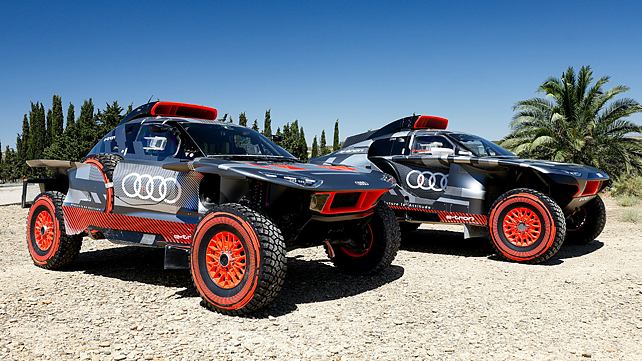
The German luxury carmaker Audi has showcased the RS Q e-tron E2 following initial testing led by Arnau Niubó Bosch. The company says it has been improved for the 2022 Morocco Rally and the 2023 Dakar Rally over the previous model.
From October 1 to 6, the vehicle will enter its first competition, the Rally du Maroc. All three Audi driver pairings will then contest the desert rally that begins and finishes in Agadir, in the southwest of the North African country.
A press release from Audi said that the body is completely new and features significantly enhanced aerodynamics, helping to lower the prototype's weight and centre of gravity.
Axel Löffler, Chief Designer, RS Q e-tron, said, 'We are now doing away with the underflow of the rear hood to the left and right of the B-pillars. In conjunction with modified lay-ups, i.e. optimised fabric layers of the composite materials, this solution reduces weight.'
The release added that Audi has now dispensed with the part of the fenders that was behind the front wheels and formed the transition to the door. Internally, this structure was called the 'elephant foot.' As a result, the designers saved more weight and optimised the airflow.
Notably, the engineers at Audi managed to reduce the overall aerodynamic drag by around 15%. In terms of the drivetrain, new operating strategies have been incorporated to improve the efficiency of the electric drivetrain further.
Interestingly, the electric drivetrain of the Audi RS Q e-tron E2 comprises an energy converter consisting of an internal combustion engine and a generator, as well as a high-voltage battery and two electric motors on the front and rear axles.
At the previous Dakar Rally, it noted short-term surpluses of power in situations where the wheels made less contact with the ground while jumping or on uneven terrain, due to which the officials of the FIA intervened at a threshold of two kilojoules of excess energy and impose sporting penalties.
To rectify this, the E2 has been installed with two individual limits -one for each motor, which is recalculated by the software within milliseconds resulting in a precise operation within the permissible limit.
Meanwhile, the interior of the rally vehicle also sees updates. It continues to feature displays that are in the driver's field of view and located in the centre console in the usual style, and the central switch panel with its 24 fields has also been retained from the previous model.
However, the engineers have restructured the displays and controls. With this, the driver and co-driver can now select from four system areas using a rotary switch.
The 'Stage' theme contains all the functions that are important while driving competitively, such as the speed limiter in sections with speed limits or the air jack, while the 'Road' part contains turn signals and the rear-view camera, functions that are often in demand on the liaison stages.
The 'Error' option is used to detect, categorise and catalogue errors, and the 'Settings' section includes everything useful for the engineering team during testing or after the car arrives at the bivouac, for example, detailed temperatures of individual systems.
Moreover, Audi noted that the previous bulky covers for the spare wheels on the flanks have been replaced by simple, flat and easily removable body components, helping the crew change repair punctures easily.
Also Read
Nunam Explores Options To Power E3W Rickshaws In India With Used Batteries Of Audi e-tron